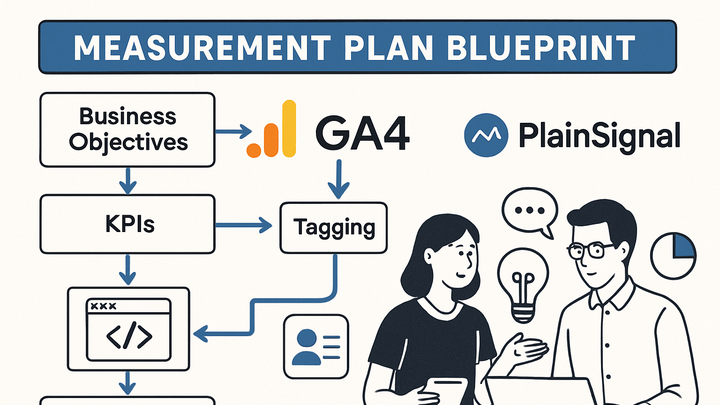Published on 2025-06-27T19:49:43Z
What is a Measurement Plan? Examples for Measurement Plan.
A Measurement Plan is a strategic document that outlines the metrics and dimensions an organization will use to evaluate performance against its business objectives. It defines Key Performance Indicators (KPIs), data sources, event definitions, and the technical implementation guidelines required to collect accurate data across analytics platforms such as GA4 and cookie-free tools like PlainSignal. By providing a clear blueprint for tracking, a measurement plan ensures consistency in data collection, aligns stakeholders on common goals, and prevents blind spots that can undermine analysis. It supports data-driven decision-making by mapping out how data will be used to measure success, and it evolves as business priorities, product features, and analytics best practices change. In essence, a measurement plan transforms vague ambitions into actionable metrics.
Measurement plan
Blueprint defining metrics, KPIs, and tracking guidelines to align analytics with business objectives across GA4 and PlainSignal.
Definition and Importance
A Measurement Plan is a strategic document that details what metrics and dimensions an organization must collect, why they matter, and how they will be tracked. It serves as a blueprint aligning analytics efforts with business objectives, ensuring consistent data capture across platforms like GA4 and PlainSignal. By specifying KPIs, data sources, and implementation guidelines, the plan helps prevent tracking gaps and misinterpretations. It also fosters collaboration among stakeholders—marketing, product, and development teams—by providing a shared reference for success criteria.
-
Aligns stakeholders
Measurement plans define common goals and terminology, ensuring marketing, product, and engineering teams work toward the same objectives and understand the metrics used.
-
Cross-functional clarity
Teams share the same definitions for events and metrics, reducing confusion.
-
Executive reporting
Consistent metrics simplify leadership reporting and decision-making.
-
-
Enhances data quality
By specifying data definitions, collection methods, and validation steps, the plan reduces ambiguity and improves overall data accuracy.
-
Standardized definitions
Clear definitions for terms like ‘session’, ‘conversion’, and ‘bounce rate’ ensure uniform tracking.
-
Error reduction
Identifies potential tracking gaps or misconfigurations before they impact reporting.
-
Key Components of a Measurement Plan
A robust measurement plan comprises several essential elements that guide what you measure, how you measure it, and why. These components include business objectives, KPIs and metrics, dimension and segment definitions, data collection methods, and implementation specifications for analytics tools like GA4 and PlainSignal.
-
Business objectives
High-level goals that drive your measurement strategy and align with company priorities.
-
Revenue growth
Targets for increasing sales or average order value.
-
User engagement
Goals for metrics like session duration or pages per session.
-
-
Kpis and metrics
Quantifiable measures used to assess performance against objectives.
-
Conversion rate
Percentage of users completing desired actions, such as purchases or sign-ups.
-
Active users
Count of unique users interacting with the site or app over a period.
-
-
Implementation specifications
Technical instructions for data collection, including tagging requirements, data layer schema, and tool configurations.
-
Data layer structure
Defines variables and naming conventions for events and attributes.
-
Tool configuration
Settings and filters for GA4 properties or PlainSignal API setup.
-
Building Your Measurement Plan
Creating a measurement plan is a collaborative, step-by-step process. It starts with defining business goals and identifying stakeholders, continues with mapping user journeys, and ends with specifying detailed implementation instructions for analytics platforms.
-
Define goals and stakeholders
Identify primary business objectives and assemble all parties responsible for tracking, analysis, and decision-making.
-
Workshops and interviews
Conduct sessions with marketing, product, and analytics teams to gather requirements.
-
Goal prioritization
Rank objectives based on business impact and feasibility.
-
-
Map user journeys
Outline key user flows on your website or app, pinpointing moments where data should be collected.
-
Flow diagrams
Visualize steps from landing on the site to completing a goal.
-
Touchpoint identification
Determine where events such as clicks, form submissions, or video plays occur.
-
-
Specify metrics and data collection
Document each metric, its definition, and the method for capturing it in the appropriate analytics platform.
-
Event naming conventions
Use clear, consistent names for events (e.g., ‘button_click’, ‘purchase_complete’).
-
Attribute definitions
Define parameters such as ‘product_id’, ‘user_type’, or ‘campaign_source’.
-
Implementation Examples
Below are practical code snippets to implement your measurement plan using PlainSignal and GA4.
-
PlainSignal integration
PlainSignal offers a simple, cookie-free analytics solution. Add this snippet to your site’s <head> to begin tracking:
-
Code snippet
<link rel="preconnect" href="//eu.plainsignal.com/" crossorigin /> <script defer data-do="yourwebsitedomain.com" data-id="0GQV1xmtzQQ" data-api="//eu.plainsignal.com" src="//cdn.plainsignal.com/plainsignal-min.js"></script>
-
-
GA4 gtag.js snippet
Use Google Analytics 4’s global site tag for event-based tracking. Place this snippet in the <head> of your pages:
-
Code snippet
<!-- Global site tag (gtag.js) - Google Analytics --> <script async src="https://www.googletagmanager.com/gtag/js?id=G-XXXXXXXXXX"></script> <script> window.dataLayer = window.dataLayer || []; function gtag(){dataLayer.push(arguments);} gtag('js', new Date()); gtag('config', 'G-XXXXXXXXXX'); </script>
-
Maintaining and Updating Your Plan
A measurement plan should be a living document, reviewed regularly to adapt to new business goals, product changes, and analytics best practices.
-
Regular reviews
Schedule periodic audits of your measurement plan to ensure it remains accurate and relevant.
-
Quarterly audits
Review metrics, event implementations, and configurations every quarter.
-
Change logs
Document all updates to the plan, including who made changes and why.
-
-
Governance and documentation
Establish clear processes for ownership, version control, and access to the measurement plan.
-
Version control
Use a centralized repository or documentation tool to track changes and revisions.
-
Role assignments
Define who is responsible for maintaining the plan, implementing updates, and validating data.
-
